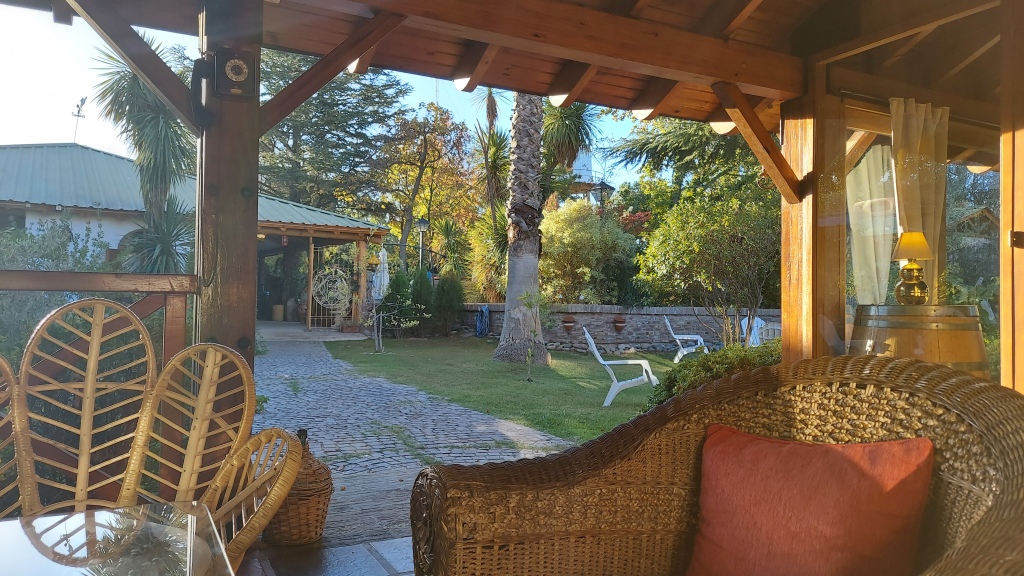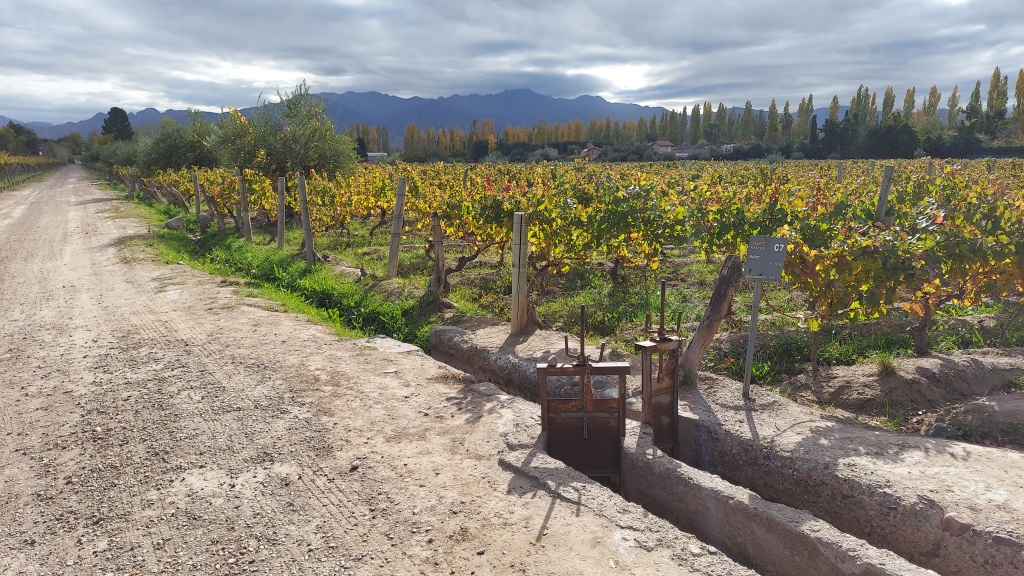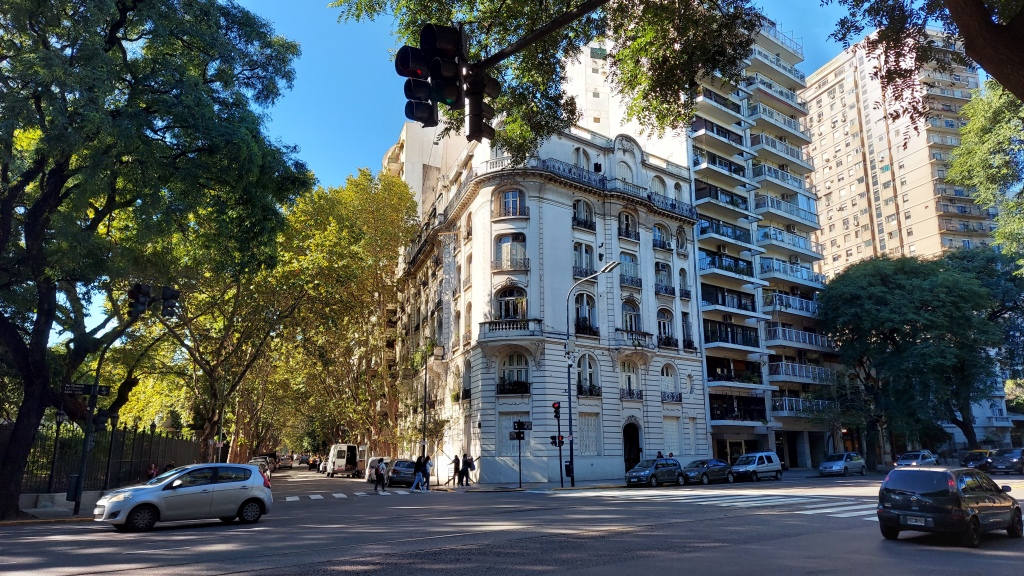This is the final installment in a four-part series. Part I | Part II | Part III
Mood shift, for the third time this trip: I head to Mendoza, a two-hour flight to the west of Buenos Aires, a city tucked in the shadow of the Andes. Mendoza gave the gift of malbec to the world, and it remains a great wine-growing region, so roughly a dozen wedding guests have made their way out here to continue the afterparty. We are strewn about between downtown Mendoza and the placid towns heading south toward the Valle de Uco, and I crash at a small bed and breakfast a block off the main square in Chacras de Coria.
Chacras is a quiet town of low-slung, walled-off houses and unassuming quality restaurants. The smell of grilling meat drifts through the air and settles over my patio seat outside my room at the B&B. Thick sycamores and elms in fall color line a network of drainage channels called acequias, a legacy of the Huarpe and Inca that break up an otherwise dusty landscape. A wine country dry heat hangs over the foothills of the Andes, and the mountains above us shiver with a strong wind pouring down, a sign snow is falling on the slopes of Aconcagua, the highest point in the Americas, some 200 kilometers to the west. By the third day the winds stop and the temperature plummets over twenty degrees, a sign of deep autumn here in Mendoza.
My B&B is the pet project of an American named Bruce, a Vietnam era fighter pilot who later flew commercial planes. Bruce has electric blue eyes, a long and scraggly mane, and is one of the more astonishing humans I have ever met. His global travels have taken him to every continent and just about every ski hill on offer, flitting from place to place, adventures in motorcycle racing, a home in Giza, a German ex-wife, and even some time in Minnesota. After decades of an itinerant life he landed in Mendoza, the house choosing him, or so he says. He is now the pilot of this little B&B, a labor of love going on 20 years.
We spend my first night in Mendoza in conversation over meat and drink, though most of it flows in one direction. He diagnoses extreme stress in me, which is both right and wrong; yes, I can be a bundle of nervous energy, these surges often a fuel and sometimes a crutch, a tension no doubt heightened in a place far from home. The lone wolf struggles to understand the chameleon, forever calibrating himself to his surroundings, but the chameleon can come to understand the wolf.
If Bruce’s goal is to give me an escape, his scattershot volleys certainly don’t help the cause. He speaks so softly that I strain to hear, and while he peppers me with questions, only rarely do I sense he is really processing my answers. He grills me on my work and its value and shares his idiosyncratic takes, sometimes insightful and sometimes leaning toward cringe, a jumbo jet on a set path that I cannot alter, and I am intrigued to just watch him fly as far as he can. Here is a man who chose the radical freedom, gave up a family and everything he knew, and now here he is on a Monday night in Chacras de Coria, Argentina, guzzling down wines and holding court for an American kid who thought he was going to have a quiet evening in to recharge his battery before exploring the vineyards. I am fascinated by him, and he has clearly done some good for quite a few locals. But I would not choose to be him.
In spite of everything, Bruce is bullish on Argentina’s future. If Uruguay is a country that just works, Argentina is one that should work but too often does not. It has a world-class capital city of 16 million people, rich agricultural and mineral resources, beautiful countryside from Patagonia all the way up the Andes. Like the United States it is a European settler society, its indigenous peoples generally wiped out or pushed to obscure corners, a tragedy that has left it on a trajectory apart from some of its Andean neighbors. Waves of immigration from Spain and Italy crashed up on its shores in the late nineteenth and early twentieth centuries with a land rush to rival the opening of the American West.
Its modern history, however, is an absolute jumble. The country has managed to escape its long run of military coups over the past 40 years, ever since the hapless Falklands War discredited the last junta, and this is a real achievement. The economy, however, is a different matter, thanks to runaway inflation and the populist patronage machine that is the Justicialist Party, Argentina’s dominant political institution since Juan and Eva Perón showed up on the scene. Putting up the Economy Minister in a nation with rampant inflation did not work out well for the Peronists in the 2023 elections, and Argentina is now running an experiment with Javier Milei, a Trumpy figure with no legislative support and five cloned dogs named after University of Chicago economists. The drama goes on, though the early returns suggest one of his ideas, the dollarization of the economy, is doing some good to stabilize prices and rein in that inflationary scourge that Argentina needs to solve before it can make good on any other promise. That promise, as these next few days show, is considerable.
Dollarization also makes Argentina an even easier country for American visitors, and for us revelers, Mendoza is a land of bountiful excess. Given the difficulty of winery logistics—here is an industry that is just begging to be disrupted—we go off on our own or in small groups, and we share an entertaining group chat. Five or six courses into my seven-course paired meal at Alta Vista (a visit arranged by Bruce and his staff; he is nothing if not a connoisseur of good taste from the whole world over), I report a state of general bliss. One wedding guest who is on a guided tour of the Valle de Uco shares he has just been served his fifth filet mignon of the day; another makes the mistake of counting how many glasses she has consumed. “We need the anti-Ozempic,” our bride writes as she ponders her dinner reservation with dread. Indeed, after a siesta and plenty of time to digest, I can only stomach a small salad for dinner in downtown Mendoza, while a tablemate pokes feebly at her eggplant. Three of us end up at a rooftop bar overlooking Mendoza’s gentle grid that night, shivering a little at the coming cold and marveling at what we are a part of here.
The next day we do manage to get a healthy group together for a tour and tasting at Kaiken, where the aging barrels are serenaded by Gregorian chant to create vibrations. (As with Dante in the Palacio Barolo, here is that credulous Latin American melodrama, a feature of a society less beset by the all-knowing cynicism that can plague educated Americans.) Guided by a sommelier, we try an array of malbecs to test the differences between them, and we eventually close the place down. I join Jess and Phil back at Entre Cielos, their sleek spa resort for their mini-moon, and we bask in the hot tub beneath the Southern Cross and hold a scattershot bilingual chat with a man from Chile and a woman from Eau Claire, Wisconsin, who have settled here together. Later, we peck at a dinner with two more friends at the resort restaurant. We order as much tea as we do wine. The body can only endure so much here.
I return to Buenos Aires for one final night in Argentina, though the energy for greater exploration has diminished now toward the end of near-constant moves from place to place. I content myself with another night at the Miravida Palermo Soho and stroll around the neighborhood, with visits to the charming Japanese Garden and the rather moribund Ecoparque zoo. One unattached fellow Hoya remains, and we sample a bumping craft brewery named Strange. The beer is superb, and the blasphemous raccoon logos are, well, something.
Once it is time to head back to the airport, I am ready to leave Argentina. I am ready to speak fluent English again, ready to sleep in my own bed; at least for two nights, that is, before the last adventure of my mini sabbatical. In the days that follow I reflect on the juxtaposition between my hunger for that freedom to wander and my natural homing instinct; my embrace of Uruguayan anonymity and my rejection of Bruce’s retreat from all prior commitment.
Is it truly a tension? I’m not so sure. They are both parts of a well-lived life, paces adjusted and waves seized. Here is yet another way to be free: to find the ease of knowing one has found one’s home in a certain place, among certain people, desire and roots aligned. This trip is all a good dream, yes, but I have work to do when I get back home. I couldn’t ask for much more.



